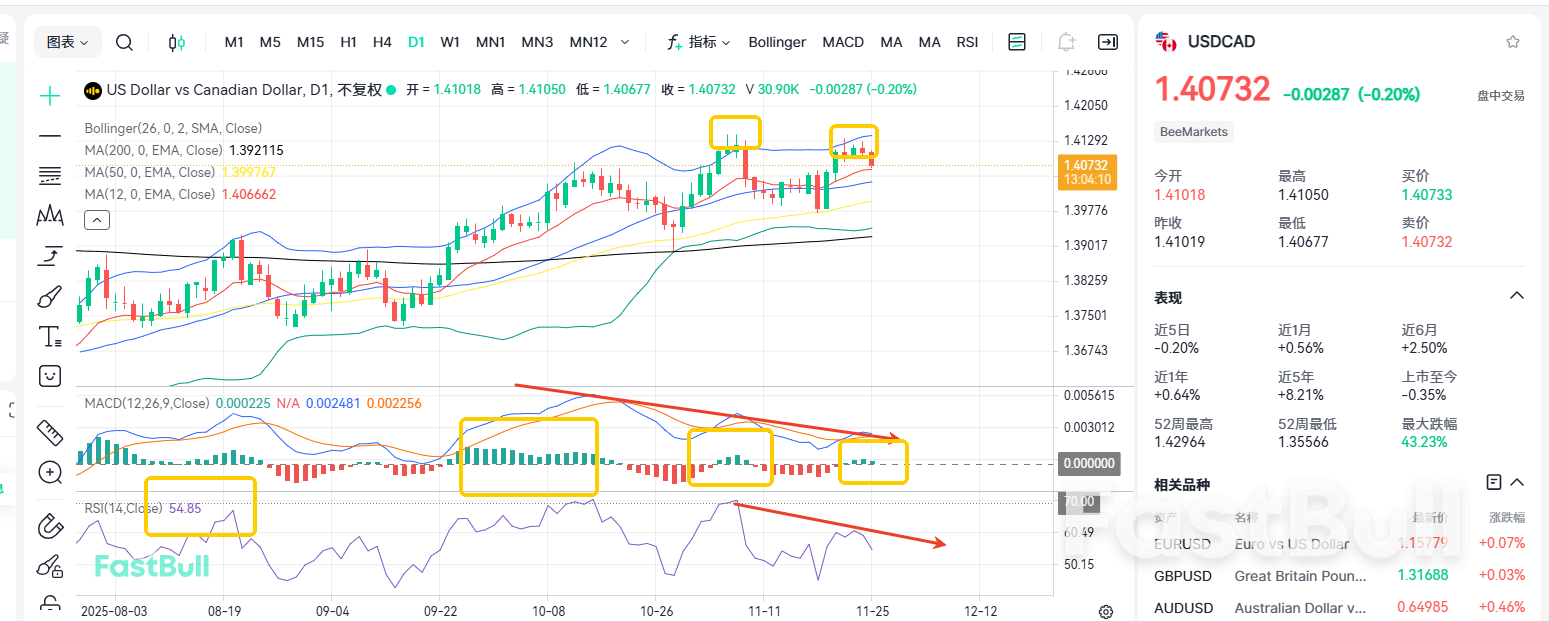Fundamentals
The Canadian dollar's exchange rate remains generally stable, with market expectations indicating that the Bank of Canada is likely to keep interest rates unchanged in the near term. At the October policy meeting, the Bank reduced its benchmark rate by 25 basis points to 2.25%, signaling the end of its monetary easing cycle. Contrarily, analysts from Citigroup project further interest rate cuts in 2026, citing potential downside risks to economic growth and inflation next year. This year, North American retail and macroeconomic environments have displayed complexity and resilience amid multiple stresses, with notable shifts in consumer behavior and price inflation in Canada and the United States. In Canada, the upcoming Black Friday shopping season has yet to commence, but retailers are already experiencing pressure due to anticipated consumer budget constraints. Ongoing inflation and rising living costs have led several surveys to suggest that Canadian shoppers may curtail holiday spending this year, compelling merchants to extend promotional campaigns from Halloween through late December. Black Friday has evolved from a single-day discount event into a multi-week promotional cycle, with retailers continuously launching incentives to maintain consumer engagement. Some small businesses have aligned with this trend to boost foot traffic and clear inventory; for instance, Wolf & Rebel in Windsor leverages substantial discounts to attract shoppers amid rising costs and tightening consumer budgets, while home decor brand VdeV participates in promotional activities driven by heightened consumer expectations for deals. Major retail chains have advanced their discount schedules and increased promotional intensity—Best Buy and Walmart, for example, initiating sales earlier than previous years and extending them over several weeks in an effort to evenly distribute customer flow and encourage early purchases. Despite the common narrative of supporting the local economy through "buying Canadian-made" products, this sentiment has diminished somewhat this year, with consumers predominantly prioritizing price considerations. Surveys by the Bank of Canada indicate that most consumers are unwilling to pay a premium for domestically manufactured goods. Against the backdrop of persistent cost-of-living pressures, pricing remains the primary driver throughout the promotional season.
According to the CME FedWatch Tool, the probability of the Federal Reserve cutting interest rates by 25 basis points to a target range of 3.50%-3.75% at the December meeting has risen from 50.1% to 85.3% over the past week. The dovish outlook from the Fed was further reinforced following remarks by New York Federal Reserve President John Williams on Friday, where he indicated potential support for a rate cut at the December policy meeting. CNBC reported Williams as saying, "I believe monetary policy is currently slightly restrictive, though somewhat less so than before recent adjustments, and there remains room for further modifications in the near term." He emphasized the necessity of further easing to sustain economic growth amid signs of a slowdown and a cooling labor market. In addition to Williams' dovish guidance, subdued U.S. economic data has exerted downward pressure on the dollar, with recent reports showing a moderation in core producer inflation, excluding volatile food and energy prices, and modest retail sales growth in September.
Technical Analysis
In the 1D timeframe for the USDCAD, the Bollinger Bands are narrowing. The EMA12 short-term moving average has flattened, and the price is oscillating near EMA12. The MACD bullish momentum is gradually weakening, with the MACD line and signal line approaching a death cross. A decline toward the EMA50 around 1.4 is highly probable. The RSI value is at 54, suggesting strong market hesitation and potential for a trend reversal. In the 4H timeframe, the Bollinger Bands are also narrowing, and the MACD's MACD line and signal line are retracing towards the zero-axis but still remain some distance away, indicating the correction is not yet complete. Support levels are at the lower Bollinger Band and EMA200, approximately 1.406 and 1.402 respectively. The RSI at 42 reflects prevailing market pessimism. It is recommended to go short at the highs.
Trading Recommendations
Trading Direction: Sell
Entry Price: 1.408
Target Price: 1.4
Stop Loss: 1.414
Support: 1.4, 1.392, 1.362
Resistance: 1.414, 1.42, 1.44














